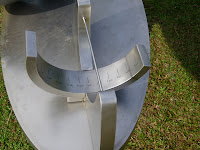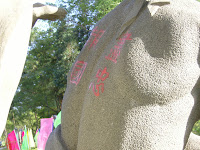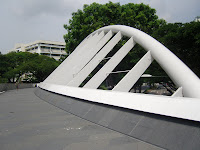
Another less hidden place of interest (I don't know if you call it a gem) in Singapore is the Chinese Garden. This replica of a Chinese garden (it contains a Japanese garden, as well; I don't really know the difference, but I think that Japanese gardens contain bonsai trees while Chinese gardens do not) is in the southwest of the island. I had wanted to visit and even got so far as the gates last year before I read the sign that said the garden would be closed for that weekend. So, I filed it in my "to do" list, and a year later was back on the MRT heading to, conveniently enough, Chinese Garden station. Off the train, through the turnstiles, and 300 metres down the path, you cross the bridge into the garden.

It really is a nice space. This is one of the places my local friends say, "Yes, I went there...when I was six!" But, it is worth a trip out on a nice day to enjoy the scenery. You have large, arched bridges that cross inlets from the sea, winding paths through forests and sculptures, old sun dials (and a more modern one - can you tell what time it was?), a garden with the 12 animals of the Chinese zodiac, a well-populated turtle pond, and statues of historical Chinese figures, from philosophers such as Confucius to warriors like Yue Fei, on whose back his mother tattooed four Chinese characters meaning: "Serve the country loyally." There are also the twin pagodas on the water and the 7-storey pagoda at the entrance to the garden.






I liked the garden with the twelve animals of the Chinese zodiac. Each year was represented with a stylized statue of two of the animals, with a plaque showing the particular years of the animal (I was born in 1968, the year of the Monkey), and the characteristics of people born during that year. The oxen (pictured here) were adorned with red ribbons, in anticipation of the new year celebrations that would take place nine days later to usher in the Year of the Ox.

I found one particularly neat feature. Singapore has built a "model" of the solar system, spread out over the island. The sun is located at the Singapore Science Center, and the nine planets are then placed in public spots in scale according to their distance from the sun. I found Venus in the Chinese garden, and Mercury is in the Japanese garden. Each of the planets occupies a space along its orbit somewhere in the city-state, with Pluto rounding out the solar system all the way to the east. I thought that was a nice touch.

It was a nice Saturday evening, so I decided to take the PCN back towards town. It was a longer walk than expected, but it led me to Bukit Batok Park, with its thick forest and quarry lake, stuck right in the middle of a residential and commercial area. Another hidden gem! Singapore is full of them.










